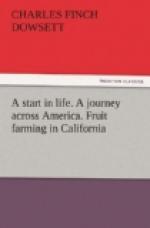CHICAGO TO SAN FRANCISCO.
The train was due at Chicago (December 2nd) at 9.45 a.m., being exactly a 23 hours and 45 minutes’ run from New York. Having crossed Chicago from one terminus to another, I found that three trains left Chicago by which I could travel to San Francisco—two were slow trains, and one a fast train; but, by whichever train I went, it would make no difference as to the time I left Omaha, and consequently no difference to the time I should arrive at San Francisco, so I went on by one of the slow trains, as I wanted to see Council Bluffs. This train was similarly fitted to the other, except that it had no drawing-room car, nor stenographer, etc., nor were the platforms connecting the carriages enclosed; so that, in passing to the dining car, or any other car, the sudden change from a hot car to a shower of snow was not pleasant. The distance from Chicago to Omaha is 492 miles, and the country between the two places formed a part of the great prairie region, which, 50 years ago, had no other inhabitant than the Indian and the trapper, but now is a succession of homesteads, villages, and towns, bearing evidence of prosperity. At Creston, and many other stations, I noticed that there is no protection whatever from the railway; the line is unfenced, and the train runs through the town as openly as a coach would; there is generally a rough board put up here and there with the words, crudely painted on them, “Look out for the cars!” We were due at Council Bluffs the next morning (December 3rd) at 7.23, but we arrived some half-hour late. Council Bluffs Station is four miles from Omaha Station, but the towns adjoin. The former has a population of over 35,000, and the latter of over 110,000. They are divided by the great Missouri River, which is crossed by two bridges, one being 2,750 feet long, and the other 2,920 feet long. Having had breakfast at the station, I went up to the town by the “motor,” that is, the electrical tram-car. The motor cars, like the railway cars, are heated. I noticed a large number of detached wooden cottages, “standing in their own grounds,” of about one-eighth of an acre, and I learned that these are owned by labourers. Mr. Day, an agent there, told me that the cottage would cost 500 dollars, and the land 400 dollars, i.e., L100 for the house, and L80 for the land. An eighth of an acre for L80 would be L640 per acre, and this quite out in the suburbs; and I was told that good business blocks in the town itself would fetch L32,000 (not dollars, but pounds) per acre. In the large cities, such as New York, Chicago, etc., prices in the principal streets would compare with prices in the City of London. Returning to the station, I joined the express train, and crossing the Missouri River to Omaha, we proceeded west. The river was frozen at its sides, and presented no attractions worth notice. On we go through hundreds of fields




